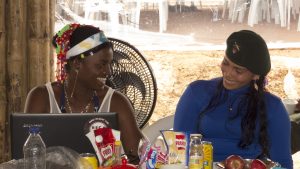 Marta and her boyfriend decided not to have children, because they thought that a child would end up suffering from being raised in the guerrilla. The woman joined the Revolutionary Armed Forces of Colombia (FARC) when she was a teenager, after a childhood between a very poor neighborhood of Bogotá and the countryside, where she suffered persecution of the paramilitary groups that controlled the area.
Marta and her boyfriend decided not to have children, because they thought that a child would end up suffering from being raised in the guerrilla. The woman joined the Revolutionary Armed Forces of Colombia (FARC) when she was a teenager, after a childhood between a very poor neighborhood of Bogotá and the countryside, where she suffered persecution of the paramilitary groups that controlled the area.
“The leaders of the FARC give us a chance to study. One day Comrade Jorge told me I could choose between medicine and dentistry,” recalls Marta. “I decided on the second because at that time there were few dentists in the guerrilla. Now I’ve been working as a dentist in the FARC for 18 years. ”
We met Marta in the middle of September in the Llanos del Yarí, a site of wonderful sunsets that is in the Department of Meta, in the south of Colombia. She was sent as a delegate to the 10th National Guerrilla Conference, where the FARC ratified the peace accords reached with the government of President Juan Manuel Santos and decided to become a political party.
However, the popular plebiscite convened for October 2 rejected the agreements signed on September 26. These news felt like a bucket of cold water for a big part of the Colombian population – the institutions, the media, social movements, civil society organizations and the FARC itself – who assumed that the “Yes” had triumphed in the plebiscite.
On November 30, the Colombian Congress voted in favor of a new agreement reached by the FARC and the Colombian government, 6 weeks after the people rejected the plebiscite. The new agreement includes some changes, among them, the FARC agreed to submit a list of their assets to be used for the material reparation fund to the victims, and the agrarian reform was restricted to the current regulations to offer greater protections to landowners. Structurally, only parts of the new agreement involving International Law would be incorporated into the Constitution.
Members of the congress who opposed the process and voting argued that there was not enough time to review the changes and abstain. The far-right represented by the Democratic Center party (whose leader is former president Álvaro Uribe) continues to criticize the peace accords, even though they incorporate many of the instances of the “no” promoters in the October 2 plebiscite.
After the signing of the new agreement, the guerrillas will move in to the 23 planned concentration zones, where they will spend six months to gradually deliver their weapons and prepare for integration into civilian life.
Once out of the concentration zone, Marta dreams of opening a clinic in the rural areas of Colombia. Ledis, a political prisoner of the Gabriel Galbis Unit of the FARC who received a special permit to participate as a delegate in the X National Guerrilla Conference, shares her dream, although she knows that before working in the clinic she would have to finish her studies, interrupted the day the army entered the university to arrest her.
“My comrades sent me to study dentistry at the University. I went as a civilian so that no one would identify me as a guerrilla. But a deserter recognized me and turned me in. At the trial I was charged with rebellion, homicide, kidnapping and sentenced to 60 years. We are not sentenced for having committed any crime, but for what we are, for being revolutionaries” says Ledis, whose eyes flashed when asked what would happen after ratification of peace agreements in the plebiscite.
“We were told that all political prisoners will be set free to the streets,” she said almost shaken. “Once free I plan to study dentistry, I want to finish the course that I already have advanced and be ready to help the party that we believe in. There will be a lot of hard work ahead, especially in rural areas.”



